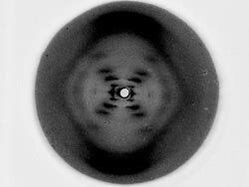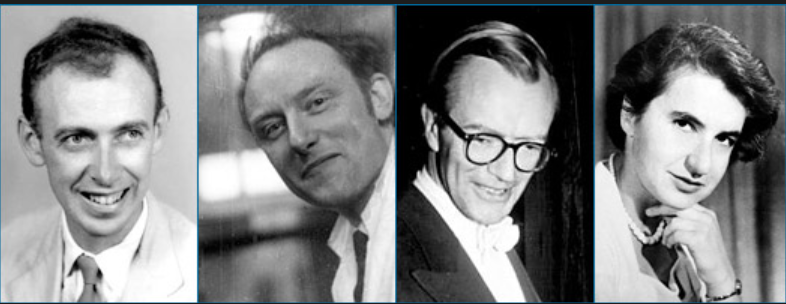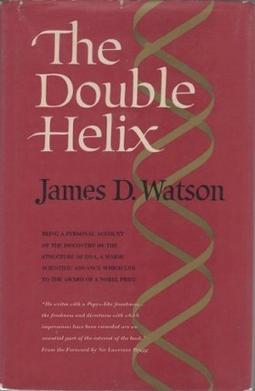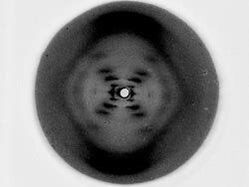|
In 1951, Rosalind Franklin went back to London to work in J. T. Randall's biophysics program at King's College. It was very different from Paris. "London in the 1950s seemed to Rosalind to be sunk in pessimism, while Paris, recovering from the horrors of occupation, was forward-looking and full of optimism," writes Jennifer Glynn in her memoir My Sister Rosalind Franklin. The work environment as well was in high contrast to her last job. Sexism was built deeply into the work environment. It was very unwelcoming in contrast to Mering's lab in Paris, as Glynn describes: "There were certainly a surprising number of women scientists at King's, but they were not allowed in the men's common room, where there was lunch and coffee and contact with colleagues--an insulting situation, even if not unusual in England at the time; it hit Rosalind particularly badly after the freedom and friendliness of the lab in the Quai Henri IV. And the immediate hostility between Rosalind and her colleague Maurice Wilkins has become notorious." This was King's College in the 1950s. This was when Franklin stepped into the famous and messy race for the structure of DNA. Franklin didn't intend to work on DNA when she came to King's College. "Franklin's fellowship proposal called for her to work on x-ray diffraction studies of proteins in solution. However, there was a shift in research priorities after Maurice Wilkins, the assistant director of Randall's lab, began working with an unusually pure sample of DNA obtained from Rudolf Signer. Excited about the possibilities, Wilkins suggested to Randall that Franklin's expertise might be better applied to this promising DNA research. Randall agreed; he wrote to Franklin in November 1950, explaining the change of plan, and stated that she and graduate student Raymond Gosling would be the only staff doing crystallographic studies of DNA. Randall did not mention Wilkins' serious interest in DNA, nor did he tell Wilkins the details of the letter. These omissions soon generated misunderstandings between Wilkins and Franklin--Franklin assumed that the x-ray diffraction studies of DNA would be her project alone; Wilkins assumed that she was joining the loosely organized research team ('Randall's Circus') at the biophysics lab, as the expert on crystallography." (The Rosalind Franklin Papers, NIH) These misconceptions heightened tensions between Franklin and Wilkins, which weren't helped by a personality conflict between the two.
I suspect that in the beginning Maurice hoped that Rosy would calm down. Yet mere inspection suggested that she would not easily bend. By choice she did not emphasize her feminine qualities. Though her features were strong, she was not unattractive and might have been quite stunning had she taken even mild interest in clothes. This she did not. There was never lipstick to contrast with her straight black hair, while at the age of thirty-one her dresses showed all the imagination of English blue-stocking adolescents. So it was quite easy to imagine her the product of an unsatisfied mother who unduly stressed the desirability of professional careers that could save bright girls from marriages to dull men. But this was not the case. Her dedicated, austere life could not be thus explained--she was the daughter of a solidly comfortable, erudite banking family. There's no question why Franklin was unhappy there. It was in this environment that Franklin worked studying DNA with x-ray crystallography. It was here that Franklin and Gosling produced the famous Photograph 51 of DNA. Wilkins showed this photo to Crick and Watson, without Franklin's knowledge or permission. Crick and Watson used this photo as crucial proof in their designs for a model of DNA. They never gave her credit for it in their journal article. The sad thing is is that Franklin never knew they took her work. We'll never get to know what she would have felt about it. Franklin died before Crick, Watson, and Wilkins were awarded the 1962 Nobel prize in medicine. Had she been alive, she might have gotten the credit she deserved.
6 Comments
Nathan E
1/11/2022 08:12:49 am
It's really sad hearing about the prejudice that Franklin faced at Kings College and how her work was stolen from her. In particular, that quote from Watson is very eye opening, but I think it's a story that people should know and it's awesome that you are telling it.
Reply
Nathan Rabinovitch
1/11/2022 08:16:59 am
From the Watson quote: "Maurice could not see any descent way". "descent" should be "decent", unless I'm misunderstanding this. If this was Watson's spelling error and not yours, then keep it in. This blog post does an great job at keeping the reader, well, reading. The content is presented in a very readable and understandable format.
Reply
Loren Sinclair
1/11/2022 10:55:37 am
Ah, thanks, yeah I typed that wrong, though it would have been great if Watson made the spelling error.
Reply
Mia Enriquez
1/11/2022 01:34:56 pm
Ah, that's Watson for you. I don't hate him, but then again, I never had to work with him.The surprise is not that his views are now long outdated -- this was a long time ago. It's just funny because he is so darn LOUD and obnoxious about everything. It only gets funnier given that he is so often been wrong or conveying some morally questionable thought process (even for his time) and often seems aware of this, but never backs down or reins himself in a little bit so he doesn't seem completely terrible and impossible to be around. And he always writes in a sneer, which after a while begins to feel like a self-parody, though I highly doubt that he feels anything but conviction in himself.
Reply
Natalie Nardino
1/11/2022 06:42:09 pm
Wow. It's been awhile since I read Watson's book. It's worse that I remembered. It was refreshing to see her perspective on the whole matter. Great post!
Reply
Anne P. Sharp
1/13/2022 07:21:54 am
This is great storytelling! Engaging and informative post. Graphics work beautifully to support the text.
Reply
Leave a Reply. |
AuthorLoren Sinclair is a high school student interested in chemistry, art, computer science, theater, and everything else! They are writing this blog to tell Rosalind Franklin's often untold tale, from her life story to the science behind her work. Archives
January 2022
CategoriesSources |




